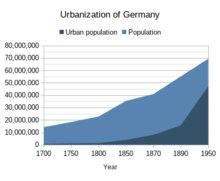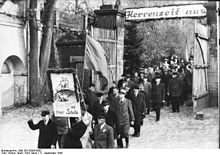Land reform in Germany
This article has multiple issues. Please help improve it or discuss these issues on the talk page. (Learn how and when to remove these template messages)
|
There have been several land reforms in Germany, also known by the German term Bodenreform.
Reforms in the Kingdom of Prussia
- In 1763, Frederick II of Prussia abolished serfdomon all Crown lands. Additionally, he issued an order to end the suppression of the peasant, relieving him and his children of domestic services to the landlord. His intentions were good – he believed that peasants should be well treated in order to function properly. But his reform did not have much effect, because the peasants had no land, and thus were forced to return to serving their previous lords in return for a right to till their lands.
- In 1798, precarioustenants.
- In 1806, Prussia was defeated by Napoleon I and lost half its territory in the second of the Prussian reforms, whose main goal was to modernize the Prussian state so that it might regain its lost power. As part of these reforms, serfdom was legally abolished throughout the kingdom. Peasants were allowed to become free proprietors of land, if they could buy it. Since peasants had no money, they were allowed to pay for the land by giving up their rights to assistance from their landlords and giving up their rights to use common lands for grazing. Alternatively, they could "pay" by giving some of their lands to their landlords. The net outcome was that the peasants' situation actually worsened: they had less land to till, and no access to common lands. On the other hand, the nobles could buy much of the peasants' lands and gained exclusive access to the common lands; so landholding became more concentrated: just the opposite of what the reformers intended.
- Over the next three decades, the government made it easier for peasants to buy land, as part of a sweep towards liberal sentiment in much of western Europe.
- After the Revolutions of 1848 in the German states, peasants refused to pay their remaining obligations to their landlords. Most of these obligations were legally abolished at 1850. The price for redeeming land was set at 25 times its annual revenue, and peasants could buy land by taking mortgages from banks.
- In 1850, Prussia began its settlement policies with the Gesetz zur Erleichterung der Ablösung durch Rentengutsverfahren. The Bauernregeln of 1859 forbid the monopolization of land by landlords.
From 1850 to 1945

Reform theories
Due to technological, medical and agricultural advances, the population of Germany rapidly grew and urbanized in the 19th century. In the 1830s, land reforms began to be discussed in Europe by various influential social economists such as Karl Marx, Friedrich Engels, Karl Kautsky and Eduard Bernstein.
An early proponent of land reform in Germany was
Inspired by the reform theories, the late 19th century also featured the parallel development of hundreds[4] of ideologically motivated[5] settlements which were sometimes funded cooperatively or by the government.
Government actions
In 1886 the
In the early 20th century, the Commission oversaw developing administrative infrastructure for interior colonization in the
At the beginning of the First World War, ideas originated for the accommodation of soldiers returning from war, such as settlements for war invalids, soldiers' homesteads[clarification needed] and peace-cities[clarification needed], as well as interior colonisation on a larger scale.[clarification needed][9]
The Reichssiedlunggesetz ("Imperial Settlement Act") was passed in 1919. This law transformed around 16,172 ha (about 62 sq miles) of marshes and wasteland into 1,761 new settlements between 1919 and 1928.[10] To hasten the resettlement of refugees from Poland the Flüchtlingssiedlungsgesetz ("Refugee Settlement Act") was passed in 1923, leading to the relocation of about 2,500 refugees.
Although settlements had been discussed as means to relieve urban poverty since 1918, results were "sobering".[9] Only 26,343 new settlements were created between 1919 and 1928; and 21,602 of these were in Prussia. This meant that only 25% of the intended area (Landlieferungssoll) of 1,413,706 ha (about 5,500 sq miles) was achieved.
In 1931 three new laws were passed to create 100,000 new settlements.[11] But the cabinet was overturned in May 1932 due to accusations of "Settlement Bolshevism".
After World War II



The land reforms in both East and West Germany had three main goals:
- to end the conservative political influence of land barons[clarification needed].
- to reallocate and integrate refugees from the former eastern territories and citizens displaced by bombings.[12][13]
- to enforce greater flexibility and efficiency in short-term agricultural production.[14]
The communist Bodenreform in East Germany nationalised all private property exceeding an area of 100 hectares (247 acres), and redistributed it to publicly owned estates.[15]
Since 1990, after German reunification, some Junkers tried to regain their former estates through civil lawsuits, but the German courts have upheld the land reforms and rebuffed all claims for compensation.[16]
See also
- Land reforms in other countries
- Flurbereinigung
- Bodenreform in East Germany
- History of German settlement in Central and Eastern Europe
- Flight and expulsion of Germans (1944–1950)
- Landesausbau
- Ostsiedlung
- Drang nach Osten
- Freiwirtschaft
- List of German utopian communities
Notes
- Otto-Lilienthal-Museum.
- ^ Theodor Hertzka: Freeland - A Social Anticipation, St. Loyes, Bedford, June, 1891. Book online at Project Gutenberg.
- ^ Meyer-Renschhausen & Berger 1998, p. 267.
- ^ Conti, Christoph (1984). Abschied vom Bürgertum. Alternative Bewegungen in Deutschland von 1890 bis heute (in German). Reinbeck.
- ^ Feuchter-Schawelka 1998, p. 232.
- ISBN 978-0-691-12362-2. Retrieved 6 March 2012.
- ^ Feuchter-Schawelka 1998, p. 227.
- ^ Archiv für Innere Kolonisation - Silesian Digital Library (1908–1933), later continued as Neues Bauerntum (1934–1944), Zeitschrift für das gesamte Siedlungswesen (1952–1955), Innere Kolonisation (1956–1972) and Innere Kolonisation, Land und Gemeinde (1972–1981)
- ^ a b Feuchter-Schawelka 1998, p. 228.
- ^ Die Deutsche ländliche Siedlung. Formen. Aufgaben. Ziele. Preussisches Ministerium für Landwirtschaft, Domänen und Forsten, 2. Aufl. Berlin 1931, p. 4
- ^ Die Deutsche ländliche Siedlung. Formen. Aufgaben. Ziele. Preussisches Ministerium für Landwirtschaft, Domänen und Forsten, 2. Aufl. Berlin 1931, pp. 3 & 206
- ^ Häbich, Theodor (1947). Das Recht der Landlosen in der US-Zone (in German). Frankfurt am Main.
{{cite book}}: CS1 maint: location missing publisher (link) p. 6 - ^ Bode 1947, p. 6 f.
- ^ Bode 1947, p. 14 ff.
- ^ Bauerkämper 1996, p. 51 ff.
- ^ Karlsruhe: Keine Rückgabe wegen Bodenreform-Enteignungen. In: Handelsblatt, 2004-12-01.
Further reading
In German
- Feuchter-Schawelka, Anne (1998). "Siedlungs- und Landkommune-Bewegung". In Kerbs, Diethart; Reulecke, Jürgen (eds.). Handbuch der deutschen Reformbewegungen 1880-1933. Wuppertal: Peter Hammer Verlag. pp. 227–244. ISBN 3-87294-787-7.
- Meyer-Renschhausen, Elisabeth; Berger, Hartwig (1998). "Bodenreform". In Kerbs, Diethart; Reulecke, Jürgen (eds.). Handbuch der deutschen Reformbewegungen 1880-1933. Wuppertal: Peter Hammer Verlag. pp. 265–276. ISBN 3-87294-787-7.
- Bauerkämper, Arnd, ed. (1996). Junkerland in Bauernhand?. Stuttgart: Steiner. ISBN 3-515-06994-1.
- Bode, August (1947). Bodenreform. Offenbach: Bollwerk-Verlag.
In English
- Powelson, John (1987). The Story of Land - [A World History of Land Tenure and Agrarian Reform]. Cambridge, MA, USA: ISBN 0899462189.
